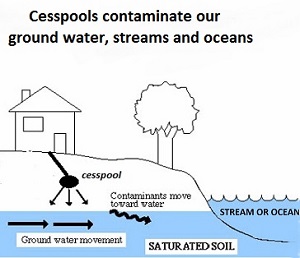Cesspools in Hawai’i

Cesspools are substandard systems. They don’t treat wastewater, they merely dispose of it. Cesspools concentrate the wastewater in one location, often deep within the ground and in direct contact with groundwater, causing groundwater contamination. This groundwater flows into drinking water wells, streams and the ocean, harming public health and the environment, including beaches and coral reefs.
What are cesspools?
- Cesspools are little more than holes in the ground that discharge raw, untreated human waste.
- Cesspools can contaminate ground water, drinking water sources, streams and oceans with disease-causing pathogens, algae-causing nutrients, and other harmful substances.
- Untreated wastewater from cesspools contains pathogens such as bacteria, protozoa and viruses that can cause gastroenteritis, Hepatitis A, conjunctivitis, leptospirosis, salmonellosis and cholera.
How many cesspools do we have in Hawai`i?
- There are approximately 88,000 cesspools in the State, with nearly 50,000 located on the Big Island, almost 14,000 on Kauai, over 12,000 on Maui, over 11,000 on Oahu and over 1,400 on Molokai.
How many cesspools pose a risk to our water resources and how do they impact our environment?
- There are 43,000 cesspools that pose a risk to our water resources.
- There are approximately 6,700 cesspools that are located within 200 feet of a perennial stream channel throughout the State. There are approximately 31,000 cesspools that are located within the perennial watersheds on the islands of Hawai`i, Kauai, Maui, and Molokai.
- Cesspools in Hawai`i release approximately 53 million gallons of untreated sewage into the ground each day.
- Cesspools have significant impact on the quality of drinking water, general water quality, the health of our reefs, and the health of Hawaii’s residents and visitors.
What is Act 125?
- Act 125 was passed in the 2017 legislative session and require the replacement of all cesspools by 2050. it directs the Hawaii Department of Health (DOH) to evaluate residential cesspools in the state, develop a Report to the Legislature that includes a prioritization method for cesspool upgrades, and work with the Department of Taxation on possible funding options to reduce the financial burden on homeowners.
Report to the Legislature – Relating to Cesspools and Prioritization for Replacement
- The report identifies 14 areas in the state where an evaluation of data on hand indicates greatest need for action.
- The report identifies four priority categories. Priority 1 are areas where cesspools present a Significant Risk of Human Impacts, Drinking Water Impacts, or Draining to Sensitive Waters. Priority 2 are areas where cesspools present a Potential to Impact Drinking Water. Priority 3 are areas where cesspools have the Potential to Impact Sensitive Waters in our state. Priority 4 is a placeholder for all cesspools whose impacts DOH have yet to fully analyze.
- The highest priority for action is located in Upcountry Maui and Kahalu’u.
How can I get a copy of the report?
- The Report is available for download: | .pdf |
Posters and Handouts from the Makawao Cesspool Community Meeting on January 9, 2018
Handouts and Powerpoint Presentation from the Kahalu’u Cesspool Community Meeting on January 12, 2018
Upcountry Maui Groundwater Nitrate Investigation Report, Appendices, PowerPoint Presentation and Public Notice
- Upcountry Maui Groundwater Nitrate Investigation Draft Report | .pdf |
- Upcountry Maui Groundwater Nitrate Investigation Draft Report Appendices | .pdf |
- Upcountry Maui Groundwater Nitrate Investigation Draft Report – Appendix VI: Groundwater Flow and Nitrogen Transport Model Report (Draft) | .pdf |
- Upcountry Maui Groundwater Nitrate Investigation PowerPoint Presentation – Kula Community Meeting on 2/21/18 | .pdf |
- Notice of Opportunity to Provide Public Comment on the Draft “Upcountry Maui Groundwater Nitrate Investigation Report” | .pdf |
Upcountry Maui Groundwater Nitrate Investigation Report – Department of Health Responses to Public Review Comments
- Department of Health Responses to Public Review Comments on the Upcountry Maui Groundwater Nitrate Investigation Report | .pdf |
Handouts from the Waimanalo Cesspool Community Meeting on May 29, 2018
- Handouts | .pdf |
Handouts from the Kailua-Kona Cesspool Community Meeting on June 29, 2018
- Handouts | .pdf |
Handouts from the Hilo Cesspool Community Meeting on July 25, 2018
- Handouts | .pdf |
